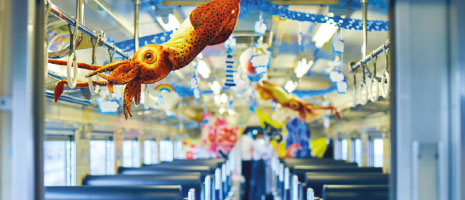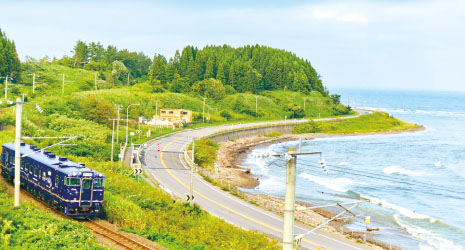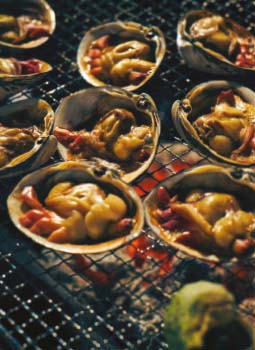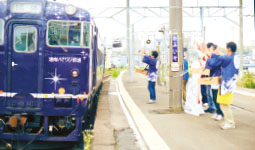Home > Highlighting JAPAN > Highlighting Japan October 2018 >A Trip by Local Train
Highlighting JAPAN


- PREVIOUS
- NEXT
Enjoy Hokkaido’s Coastline and a BBQ Feast from the Land and Sea
As dusk falls, Hokkaido’s Nagamare Kaikyo train takes riders on a leisurely run past the Tsugaru Strait and Mount Hakodate. The beautiful dark-blue sightseeing car that allows passengers to enjoy singular regional hospitality and cuisine was named Japan’s best train journey of the year for 2016.
The South Hokkaido Railway’s Donan Isaribi Tetsudo Line runs for 38 kilometers from Hakodate City alongside the Tsugaru Strait to Kikonai, a town of roughly four thousand people. The opening of the Hokkaido Shinkansen in 2016 nearly put this older railway running parallel to it out of business, but the line was revived as a third-sector venture to ensure that citizens living along the route could get around.
To generate buzz for that venture, the line runs a one-car sightseeing train twice a month between May and October called the Nagamare Kaikyo. Nagamare means “to take it easy” in the local south Hokkaido dialect, and true to its name this train runs at a relaxed pace. Because it operates on a shoestring budget, the Nagamare Kaikyo was once called “Japan’s poorest tourist train.” After the service began incorporating clever ways to highlight the best characteristics of the area along the line and interactions with local people, however, it won Tetsutabi (Train Journey) of the Year in 2016.
Passengers boarding the Nagamare Kaikyo at Hakodate Station are sure to smile at the decorations bursting with handmade charm, such as brightly colored fisherman’s flags and stuffed squid plush toys. When it departs at exactly 3:51 p.m., railway staffers send passengers off with a banner that reads, “Have a good trip!” These heartfelt touches and the fact that the one-car train quickly fills up with around fifty passengers add to the sense of excitement.
When the Nagamare Kaikyo reaches its first stop, Kamiiso Station, happi coat-clad vendors from the local shopping street come to the train windows to peddle their wares—snack boxes stuffed full of local delicacies, such as hokki clam dumplings and sweets. They do this right through the open windows, since the KiHa 40 series train is an older model, which is refreshingly different and welcoming in this day and age.
After the train departs Kamiiso, the Tsugaru Strait spreads out before you. The train stops for a few minutes to allow all aboard to savor the breathtaking views of Hakodate Bay at the foot of Mount Hakodate, the first of many such pauses and slowdowns for the scenic spots the train passes.
Passengers typically get off the train at Kikonai where the route loops back around to buy souvenirs at the roadside station Misogi-no-Sato Kikonai. When they return to their seats, they find a “South Hokkaido Pasta Set” there—a specialty of an Italian restaurant in the station. In addition to a mini version of the daily special short pasta, there’s a salt bun, which is the pride of Kikonai.
Those are just appetizers, however, because when the train pulls in to Moheji Station at 7 p.m. a mouthwatering aroma and feast await. Locals are grilling seasonal seafood, meat and vegetables right on the platform. On that particular day they were arranging whelk, Sakhalin surf clams, lamb meat, corn and May Queen potatoes into BBQ bento boxes, all still hot from the grill.
For the last thirty minutes of the journey, the train lights are dimmed so that everyone can get a perfect view of Hakodate City’s captivating lights along the coastline.
Between July and September—the squid-fishing months—fires set at night to luresea creatures can be seen along the coast. The train slides into Hakodate Station at 7:47 p.m., and South Hokkaido Railway staffers are there to greet its riders again, this time with a hearty “Welcome back!”
“On this train line you can enjoy hospitality built on a cozy ambience and friendly communication,” says Michihiro Harui of South Hokkaido Railway’s operation and planning division. “We’d love it if interacting with the locals leads you to explore the area along the train line.”
If you decide to follow up on Harui’s suggestion, it might be fun to board a local train, stop at the stations this train bypasses, and explore as far as the famous Trappist monastery in Hokuto City.
- PREVIOUS
- NEXT
© 2009 Cabinet Office, Government of Japan








